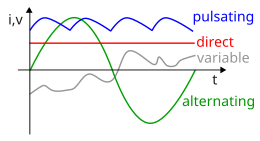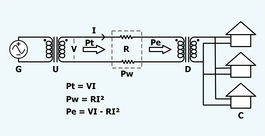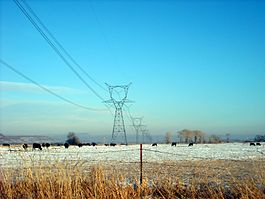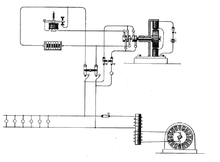Alternating current
This articleneeds additional citations forverification.(March 2023) |

| Articles about |
| Electromagnetism |
|---|
 |
Alternating current(AC) is anelectric currentthat periodically reverses direction and changes its magnitude continuously with time, in contrast todirect current(DC), which flows only in one direction. Alternating current is the form in whichelectric poweris delivered to businesses and residences, and it is the form ofelectrical energythat consumers typically use when they plugkitchen appliances,televisions,fansandelectric lampsinto awall socket.The abbreviationsACandDCare often used to mean simplyalternatinganddirect,respectively, as when they modifycurrentorvoltage.[1][2]
The usualwaveformof alternating current in most electric power circuits is asine wave,whose positive half-period corresponds with positive direction of the current and vice versa (the full period is called acycle). In certain applications, likeguitar amplifiers,different waveforms are used, such astriangular wavesorsquare waves.Audioandradiosignals carried on electrical wires are also examples of alternating current. These types of alternating current carry information such as sound (audio) or images (video) sometimes carried bymodulationof an AC carrier signal. These currents typically alternate at higher frequencies than those used in power transmission.
Transmission, distribution, and domestic power supply[edit]

Electrical energy is distributed as alternating current because ACvoltagemay be increased or decreased with atransformer.This allows the power to be transmitted throughpower linesefficiently athigh voltage,which reduces the energy lost as heat due toresistanceof the wire, and transformed to a lower, safer voltage for use. Use of a higher voltage leads to significantly more efficient transmission of power. The power losses () in the wire are a product of the square of the current ( I ) and theresistance(R) of the wire, described by the formula:
This means that when transmitting a fixed power on a given wire, if the current is halved (i.e. the voltage is doubled), the power loss due to the wire's resistance will be reduced to one quarter.
The power transmitted is equal to the product of the current and the voltage (assuming no phase difference); that is,
Consequently, power transmitted at a higher voltage requires less loss-producing current than for the same power at a lower voltage. Power is often transmitted at hundreds of kilovolts onpylons,and transformed down to tens of kilovolts to be transmitted on lower level lines, and finally transformed down to 100 V – 240 V for domestic use.

High voltages have disadvantages, such as the increased insulation required, and generally increased difficulty in their safe handling. In apower plant,energy is generated at a convenient voltage for the design of agenerator,and then stepped up to a high voltage for transmission. Near the loads, the transmission voltage is stepped down to the voltages used by equipment. Consumer voltages vary somewhat depending on the country and size of load, but generally motors and lighting are built to use up to a few hundred volts between phases. The voltage delivered to equipment such as lighting and motor loads is standardized, with an allowable range of voltage over which equipment is expected to operate. Standard power utilization voltages and percentage tolerance vary in the differentmains power systemsfound in the world.
High-voltage direct-current(HVDC) electric power transmission systems have become more viable as technology has provided efficient means of changing the voltage of DC power. Transmission with high voltage direct current was not feasible in the early days ofelectric power transmission,as there was then no economically viable way to step the voltage of DC down for end user applications such as lighting incandescent bulbs.
Three-phaseelectrical generation is very common. The simplest way is to use three separate coils in the generatorstator,physically offset by an angle of 120° (one-third of a complete 360° phase) to each other. Three current waveforms are produced that are equal in magnitude and 120°out of phaseto each other. If coils are added opposite to these (60° spacing), they generate the same phases with reversepolarityand so can be simply wired together. In practice, higher "pole orders" are commonly used. For example, a 12-pole machine would have 36 coils (10° spacing). The advantage is that lower rotational speeds can be used to generate the same frequency. For example, a 2-pole machine running at 3600 rpm and a 12-pole machine running at 600 rpm produce the same frequency; the lower speed is preferable for larger machines. If the load on a three-phase system is balanced equally among the phases, no current flows through theneutral point.Even in the worst-case unbalanced (linear) load, the neutral current will not exceed the highest of the phase currents. Non-linear loads (e.g. the switch-mode power supplies widely used) may require an oversized neutral bus and neutral conductor in the upstream distribution panel to handleharmonics.Harmonics can cause neutral conductor current levels to exceed that of one or all phase conductors.
For three-phase at utilization voltages a four-wire system is often used. When stepping down three-phase, a transformer with a Delta (3-wire) primary and a Star (4-wire, center-earthed) secondary is often used so there is no need for a neutral on the supply side. For smaller customers (just how small varies by country and age of the installation) only asingle phaseand neutral, or two phases and neutral, are taken to the property. For larger installations all three phases and neutral are taken to the main distribution panel. From the three-phase main panel, both single and three-phase circuits may lead off.Three-wire single-phasesystems, with a single center-tapped transformer giving two live conductors, is a common distribution scheme for residential and small commercial buildings in North America. This arrangement is sometimes incorrectly referred to as "two phase". A similar method is used for a different reason on construction sites in the UK. Small power tools and lighting are supposed to be supplied by a local center-tapped transformer with a voltage of 55 V between each power conductor and earth. This significantly reduces the risk ofelectric shockin the event that one of the live conductors becomes exposed through an equipment fault whilst still allowing a reasonable voltage of 110 V between the two conductors for running the tools.
Athird wire,called the bond (or earth) wire, is often connected between non-current-carrying metal enclosures and earth ground. This conductor provides protection from electric shock due to accidental contact of circuit conductors with the metal chassis of portable appliances and tools. Bonding all non-current-carrying metal parts into one complete system ensures there is always a lowelectrical impedancepath to ground sufficient to carry anyfaultcurrent for as long as it takes for the system to clear the fault. This low impedance path allows the maximum amount of fault current, causing the overcurrent protection device (breakers, fuses) to trip or burn out as quickly as possible, bringing the electrical system to a safe state. All bond wires are bonded to ground at the main service panel, as is the neutral/identified conductor if present.
AC power supply frequencies[edit]
Thefrequency of the electrical systemvaries by country and sometimes within a country; most electric power is generated at either 50 or 60Hertz.Some countries have a mixture of 50 Hz and 60 Hz supplies, notablyelectricity power transmission in Japan.
Low frequency[edit]
A low frequency eases the design of electric motors, particularly for hoisting, crushing and rolling applications, and commutator-typetraction motorsfor applications such asrailways.However, low frequency also causes noticeable flicker inarc lampsandincandescent light bulbs.The use of lower frequencies also provided the advantage of lower transmission losses, which are proportional to frequency.
The original Niagara Falls generators were built to produce 25 Hz power, as a compromise between low frequency for traction and heavy induction motors, while still allowing incandescent lighting to operate (although with noticeable flicker). Most of the 25 Hz residential and commercial customers for Niagara Falls power were converted to 60 Hz by the late 1950s, although some[which?]25 Hz industrial customers still existed as of the start of the 21st century. 16.7 Hz power (formerly 16 2/3 Hz) is still used in some European rail systems, such as inAustria,Germany,Norway,SwedenandSwitzerland.
High frequency[edit]
Off-shore, military, textile industry, marine, aircraft, and spacecraft applications sometimes use 400 Hz, for benefits of reduced weight of apparatus or higher motor speeds. Computermainframesystems were often powered by 400 Hz or 415 Hz for benefits ofripplereduction while using smaller internal AC to DC conversion units.[citation needed]
Effects at high frequencies[edit]
A direct current flows uniformly throughout the cross-section of a homogeneouselectrically conductingwire. An alternating current of any frequency is forced away from the wire's center, toward its outer surface. This is because an alternating current (which is the result of the acceleration ofelectric charge) createselectromagnetic waves(a phenomenon known aselectromagnetic radiation). Electric conductors are not conducive to electromagnetic waves (aperfect electric conductorprohibits all electromagnetic waves within its boundary), so a wire that is made of a non-perfect conductor (a conductor with finite, rather than infinite, electrical conductivity) pushes the alternating current, along with their associated electromagnetic fields, away from the wire's center. The phenomenon of alternating current being pushed away from the center of the conductor is calledskin effect,and a direct current does not exhibit this effect, since a direct current does not create electromagnetic waves.
At very high frequencies, the current no longer flowsinthe wire, but effectively flowsonthe surface of the wire, within a thickness of a fewskin depths.The skin depth is the thickness at which the current density is reduced by 63%. Even at relatively low frequencies used for power transmission (50 Hz – 60 Hz), non-uniform distribution of current still occurs in sufficiently thickconductors.For example, the skin depth of a copper conductor is approximately 8.57 mm at 60 Hz, so high current conductors are usually hollow to reduce their mass and cost. This tendency of alternating current to flow predominantly in the periphery of conductors reduces the effective cross-section of the conductor. This increases the effective ACresistanceof the conductor, since resistance is inversely proportional to the cross-sectional area. A conductor's AC resistance is higher than its DC resistance, causing a higher energy loss due toohmic heating(also called I2R loss).
Techniques for reducing AC resistance[edit]
For low to medium frequencies, conductors can be divided into stranded wires, each insulated from the others, with the relative positions of individual strands specially arranged within the conductor bundle. Wire constructed using this technique is calledLitz wire.This measure helps to partially mitigate skin effect by forcing more equal current throughout the total cross section of the stranded conductors. Litz wire is used for makinghigh-Qinductors,reducing losses in flexible conductors carrying very high currents at lower frequencies, and in the windings of devices carrying higherradio frequencycurrent (up to hundreds of kilohertz), such as switch-modepower suppliesandradio frequencytransformers.
Techniques for reducing radiation loss[edit]
As written above, an alternating current is made ofelectric chargeunder periodicacceleration,which causesradiationofelectromagnetic waves.Energy that is radiated is lost. Depending on the frequency, different techniques are used to minimize the loss due to radiation.
Twisted pairs[edit]
At frequencies up to about 1 GHz, pairs of wires are twisted together in a cable, forming atwisted pair.This reduces losses fromelectromagnetic radiationandinductive coupling.A twisted pair must be used with abalancedsignalling system, so that the two wires carry equal but opposite currents. Each wire in a twisted pair radiates a signal, but it is effectively cancelled by radiation from the other wire, resulting in almost no radiation loss.
Coaxial cables[edit]
Coaxial cablesare commonly used ataudio frequenciesand above for convenience. A coaxial cable has a conductive wire inside a conductive tube, separated by adielectriclayer. The current flowing on the surface of the inner conductor is equal and opposite to the current flowing on the inner surface of the outer tube. The electromagnetic field is thus completely contained within the tube, and (ideally) no energy is lost to radiation or coupling outside the tube. Coaxial cables have acceptably small losses for frequencies up to about 5 GHz. Formicrowavefrequencies greater than 5 GHz, the losses (due mainly to the dielectric separating the inner and outer tubes being a non-ideal insulator) become too large, makingwaveguidesa more efficient medium for transmitting energy. Coaxial cables often use a perforated dielectric layer to separate the inner and outer conductors in order to minimize the power dissipated by the dielectric.
Waveguides[edit]
Waveguidesare similar to coaxial cables, as both consist of tubes, with the biggest difference being that waveguides have no inner conductor. Waveguides can have any arbitrary cross section, but rectangular cross sections are the most common. Because waveguides do not have an inner conductor to carry a return current, waveguides cannot deliver energy by means of anelectric current,but rather by means of aguidedelectromagnetic field.Althoughsurface currentsdo flow on the inner walls of the waveguides, those surface currents do not carry power. Power is carried by the guided electromagnetic fields. The surface currents are set up by the guided electromagnetic fields and have the effect of keeping the fields inside the waveguide and preventing leakage of the fields to the space outside the waveguide. Waveguides have dimensions comparable to thewavelengthof the alternating current to be transmitted, so they are feasible only at microwave frequencies. In addition to this mechanical feasibility,electrical resistanceof the non-ideal metals forming the walls of the waveguide causesdissipationof power (surface currents flowing on lossyconductorsdissipate power). At higher frequencies, the power lost to this dissipation becomes unacceptably large.
Fiber optics[edit]
At frequencies greater than 200 GHz, waveguide dimensions become impractically small, and theohmic lossesin the waveguide walls become large. Instead,fiber optics,which are a form of dielectric waveguides, can be used. For such frequencies, the concepts of voltages and currents are no longer used.
Mathematics of AC voltages[edit]

- Peak,
- Peak-to-peak amplitude,
- Effective value,
- Period
Alternating currents are accompanied (or caused) by alternating voltages. An AC voltagevcan be described mathematically as afunctionof time by the following equation:
- ,
where
- is the peak voltage (unit:volt),
- is theangular frequency(unit:radians per second).The angular frequency is related to the physical frequency,(unit:hertz), which represents the number of cycles per second, by the equation.
- is the time (unit:second).
The peak-to-peak value of an AC voltage is defined as the difference between its positive peak and its negative peak. Since the maximum value ofis +1 and the minimum value is −1, an AC voltage swings betweenand.The peak-to-peak voltage, usually written asor,is therefore.
Root mean square voltage[edit]

Below anAC waveform(with noDC component) is assumed.
The RMS voltage is the square root of themeanover one cycle of the square of the instantaneous voltage.
- For an arbitrary periodic waveformof period:
- For a sinusoidal voltage:
- where thetrigonometric identityhas been used and the factoris called thecrest factor,which varies for different waveforms.
- For atriangle waveformcentered about zero
- For asquare waveformcentered about zero
Power[edit]
The relationship between voltage and the power delivered is:
- ,
whererepresents a load resistance.
Rather than using instantaneous power,,it is more practical to use a time-averaged power (where the averaging is performed over any integer number of cycles). Therefore, AC voltage is often expressed as aroot mean square(RMS) value, written as,because
- Power oscillation
For this reason, AC power's waveform becomesFull-wave rectifiedsine, and its fundamental frequency is double of the one of the voltage's.
Examples of alternating current[edit]
To illustrate these concepts, consider a 230 V ACmainssupply used inmany countriesaround the world. It is so called because itsroot mean squarevalue is 230 V. This means that the time-averaged power deliveredis equivalent to the power delivered by a DC voltage of 230 V. To determine the peak voltage (amplitude), we can rearrange the above equation to:
For 230 V AC, the peak voltageis therefore,which is about 325 V, and the peak poweris,that is 460 RW. During the course of one cycle (two cycle as the power) the voltage rises from zero to 325 V, the power from zero to 460 RW, and both falls through zero. Next, the voltage descends to reverse direction, -325 V, but the power ascends again to 460 RW, and both returns to zero.
Information transmission[edit]
Alternating current is used to transmitinformation,as in the cases oftelephoneandcable television.Information signals are carried over a wide range of AC frequencies.POTStelephone signals have a frequency of about 3 kHz, close to thebasebandaudio frequency. Cable television and other cable-transmitted information currents may alternate at frequencies of tens to thousands of megahertz. These frequencies are similar to the electromagnetic wave frequencies often used to transmit the same types of informationover the air.
History[edit]
The firstalternatorto produce alternating current was an electric generator based onMichael Faraday's principles constructed by the French instrument makerHippolyte Pixiiin 1832.[3]Pixii later added acommutatorto his device to produce the (then) more commonly used direct current. The earliest recorded practical application of alternating current is byGuillaume Duchenne,inventor and developer ofelectrotherapy.In 1855, he announced that AC was superior todirect currentfor electrotherapeutic triggering of muscle contractions.[4]Alternating current technology was developed further by the HungarianGanz Workscompany (1870s), and in the 1880s:Sebastian Ziani de Ferranti,Lucien Gaulard,andGalileo Ferraris.
In 1876, Russian engineerPavel Yablochkovinvented a lighting system where sets of induction coils were installed along a high voltage AC line. Instead of changing voltage, the primary windings transferred power to the secondary windings which were connected to one or several'electric candles'(arc lamps) of his own design,[5][6]used to keep the failure of one lamp from disabling the entire circuit.[5]In 1878, theGanz factory,Budapest, Hungary, began manufacturing equipment for electric lighting and, by 1883, had installed over fifty systems inAustria-Hungary.Their AC systems used arc and incandescent lamps, generators, and other equipment.[7]
Transformers[edit]
Alternating current systems can usetransformersto change voltage from low to high level and back, allowing generation and consumption at low voltages but transmission, possibly over great distances, at high voltage, with savings in the cost of conductors and energy losses. A bipolar open-corepower transformerdeveloped byLucien GaulardandJohn Dixon Gibbswas demonstrated in London in 1881, and attracted the interest ofWestinghouse.They also exhibited the invention inTurinin 1884. However, these early induction coils with open magnetic circuits are inefficient at transferring power toloads.Until about 1880, the paradigm for AC power transmission from a high voltage supply to a low voltage load was a series circuit. Open-core transformers with a ratio near 1:1 were connected with their primaries in series to allow use of a high voltage for transmission while presenting a low voltage to the lamps. The inherent flaw in this method was that turning off a single lamp (or other electric device) affected the voltage supplied to all others on the same circuit. Many adjustable transformer designs were introduced to compensate for this problematic characteristic of the series circuit, including those employing methods of adjusting the core or bypassing the magnetic flux around part of a coil.[8]The direct current systems did not have these drawbacks, giving it significant advantages over early AC systems.
In the UK,Sebastian de Ferranti,who had been developing AC generators and transformers in London since 1882, redesigned the AC system at theGrosvenor Gallery power stationin 1886 for the London Electric Supply Corporation (LESCo) including alternators of his own design and open core transformer designs with serial connections for utilization loads - similar to Gaulard and Gibbs.[9]In 1890, he designedtheir power station at Deptford[10]and converted the Grosvenor Gallery station across the Thames into anelectrical substation,showing the way to integrate older plants into a universal AC supply system.[11]
Pioneers[edit]


In the autumn[ambiguous]of 1884,Károly Zipernowsky,Ottó BláthyandMiksa Déri(ZBD), three engineers associated with theGanz Worksof Budapest, determined that open-core devices were impractical, as they were incapable of reliably regulating voltage.[12]Bláthy had suggested the use of closed cores, Zipernowsky had suggested the use ofparallel shunt connections,and Déri had performed the experiments;[13]In their joint 1885 patent applications for novel transformers (later called ZBD transformers), they described two designs with closed magnetic circuits where copper windings were either wound around a ring core of iron wires or else surrounded by a core of iron wires.[8]In both designs, the magnetic flux linking the primary and secondary windings traveled almost entirely within the confines of the iron core, with no intentional path through air (seetoroidal cores). The new transformers were 3.4 times more efficient than the open-core bipolar devices of Gaulard and Gibbs.[14]The Ganz factory in 1884 shipped the world's first five high-efficiency AC transformers.[15]This first unit had been manufactured to the following specifications: 1,400 W, 40 Hz, 120:72 V, 11.6:19.4 A, ratio 1.67:1, one-phase, shell form.[15]
The ZBD patents included two other major interrelated innovations: one concerning the use of parallel connected, instead of series connected, utilization loads, the other concerning the ability to have high turns ratio transformers such that the supply network voltage could be much higher (initially 1400 V to 2000 V) than the voltage of utilization loads (100 V initially preferred).[16][17]When employed in parallel connected electric distribution systems, closed-core transformers finally made it technically and economically feasible to provide electric power for lighting in homes, businesses and public spaces.[18][19] The other essential milestone was the introduction of 'voltage source, voltage intensive' (VSVI) systems'[20]by the invention of constant voltage generators in 1885.[21]In early 1885, the three engineers also eliminated the problem ofeddy currentlosses with the invention of the lamination of electromagnetic cores.[22]Ottó Bláthy also invented the first ACelectricity meter.[23][24][25][26]
The AC power system was developed and adopted rapidly after 1886 due to its ability to distribute electricity efficiently over long distances, overcoming the limitations of thedirect currentsystem. In 1886, the ZBD engineers designed the world's firstpower stationthat used AC generators to power a parallel-connected common electrical network, the steam-powered Rome-Cerchi power plant.[27]The reliability of the AC technology received impetus after the Ganz Works electrified a large European metropolis:Romein 1886.[27]

(US patent 373035)
Building on the advancement of AC technology in Europe,[28]George Westinghousefounded theWestinghouse Electricin Pittsburgh, Pennsylvania, on January 8, 1886.[29]The new firm became active in developing alternating current (AC) electric infrastructure throughout the United States. TheEdison Electric Light Companyheld an option on the US rights for the Ganz ZBD transformers, requiring Westinghouse to pursue alternative designs on the same principles. George Westinghouse had bought Gaulard and Gibbs' patents for $50,000 in February 1886.[30]He assigned toWilliam Stanleythe task of redesigning the Gaulard and Gibbs transformer for commercial use in United States.[31]On March 20, 1886, Stanley conducted a demonstrative experiment inGreat Barrington:ASiemensgenerator's voltage of 500 volts was converted into 3000 volts, and then the voltage was stepped down to 500 volts by six Westinghouse transformers. With this setup, the Westinghouse company successfully powered thirty 100-volt incandescent bulbs in twenty shops along the main street of Great Barrington.[32]The spread of Westinghouse and other AC systems triggered a push back in late 1887 byThomas Edison(a proponent of direct current), who attempted to discredit alternating current as too dangerous in a public campaign called the "war of the currents".In 1888, alternating current systems gained further viability with introduction of a functionalAC motor,something these systems had lacked up till then. The design, aninduction motor,was independently invented byGalileo FerrarisandNikola Tesla(with Tesla's design being licensed by Westinghouse in the US). This design was independently further developed into the modern practicalthree-phaseform byMikhail Dolivo-DobrovolskyandCharles Eugene Lancelot Brownin Germany on one side,[33]andJonas Wenströmin Sweden on the other, though Brown favoured the two-phase system.
TheAmes Hydroelectric Generating Plantand the original Niagara FallsAdams Power Plantwere among the first hydroelectric alternating current power plants. The first long distance transmission of single-phase electricity was from a hydroelectric generating plant in Oregon at Willamette Falls which in 1890 sent power fourteen miles downriver to downtown Portland for street lighting.[34]In 1891, a second transmission system was installed in Telluride Colorado.[35]The San Antonio Canyon Generator was the third commercial single-phase hydroelectric AC power plant in the United States to provide long-distance electricity. It was completed on December 31, 1892, byAlmarian William Deckerto provide power to the city ofPomona, California,which was 14 miles away. Meanwhile, the possibility of transferring electrical power from a waterfall at a distance was explored at theGrängesbergmine in Sweden. A45mfall at Hällsjön, Smedjebackens kommun, where a small iron work had been located, was selected. In 1893, a three-phase9.5kvsystem was used to transfer 400horsepowera distance of15km,becoming the first commercial application.[36] In 1893, Decker designed the first American commercialthree-phasepower plant using alternating current—the hydroelectricMill Creek No. 1 Hydroelectric PlantnearRedlands, California.Decker's design incorporated 10 kV three-phase transmission and established the standards for the complete system of generation, transmission and motors used in USA today. TheJaruga Hydroelectric Power Plantin Croatia was set in operation on 28 August 1895. The twogenerators(42 Hz, 550 kW each) and the transformers were produced and installed by the Hungarian companyGanz.The transmission line from the power plant to the City ofŠibenikwas 11.5 kilometers (7.1 mi) long on wooden towers, and the municipal distribution grid 3000 V/110 V included six transforming stations.
Alternating current circuit theory developed rapidly in the latter part of the 19th and early 20th century. Notable contributors to the theoretical basis of alternating current calculations includeCharles Steinmetz,Oliver Heaviside,and many others.[37][38]Calculations in unbalanced three-phase systems were simplified by thesymmetrical componentsmethods discussed byCharles LeGeyt Fortescuein 1918.
See also[edit]
References[edit]
- ^N. N. Bhargava & D. C. Kulshreshtha (1983).Basic Electronics & Linear Circuits.Tata McGraw-Hill Education. p. 90.ISBN978-0-07-451965-3.
- ^National Electric Light Association (1915).Electrical meterman's handbook.Trow Press. p. 81.
- ^"Pixii Machine invented by Hippolyte Pixii, National High Magnetic Field Laboratory".Archived fromthe originalon 2008-09-07.Retrieved2012-03-23.
- ^Licht, Sidney Herman (1967). "History of Electrotherapy".Therapeutic Electricity and Ultraviolet Radiation(2 ed.). New Haven. pp. 1–70.ISBN9780853240631.
{{cite book}}:CS1 maint: location missing publisher (link) - ^ab"Stanley Transformer".Los Alamos National Laboratory;University of Florida.Archived fromthe originalon 2009-01-19.RetrievedJan 9,2009.
- ^De Fonveille, W. (Jan 22, 1880)."Gas and Electricity in Paris".Nature.21(534): 283.Bibcode:1880Natur..21..282D.doi:10.1038/021282b0.RetrievedJan 9,2009.
- ^Hughes, Thomas P. (1993).Networks of Power: Electrification in Western Society, 1880–1930.Baltimore: The Johns Hopkins University Press. p. 96.ISBN0-8018-2873-2.RetrievedSep 9,2009.
- ^abUppenborn, F. J. (1889).History of the Transformer.London: E. & F. N. Spon. pp. 35–41.
- ^Hughes (1993),p. 98.
- ^"Ferranti Timeline".Museum of Science and Industry (Manchester).Archived fromthe originalon 2015-10-03.RetrievedFebruary 22,2012.
- ^Hughes (1993),p. 208.
- ^Hughes (1993),p. 95.
- ^Smil, Vaclav (2005).Creating the Twentieth Century: Technical Innovations of 1867–1914 and Their Lasting Impact.Oxford: Oxford University Press. p.71.ISBN978-0-19-803774-3.
ZBD transformer.
- ^Jeszenszky, Sándor."Electrostatics and Electrodynamics at Pest University in the Mid-19th Century"(PDF).University of Pavia.Archived(PDF)from the original on 2022-10-09.RetrievedMar 3,2012.
- ^abHalacsy, A. A.; Von Fuchs, G. H. (April 1961). "Transformer Invented 75 Years Ago".IEEE Transactions of the American Institute of Electrical Engineers.80(3): 121–125.doi:10.1109/AIEEPAS.1961.4500994.S2CID51632693.
- ^"Hungarian Inventors and Their Inventions".Institute for Developing Alternative Energy in Latin America. Archived fromthe originalon 2012-03-22.RetrievedMar 3,2012.
- ^"Bláthy, Ottó Titusz".Budapest University of Technology and Economics, National Technical Information Centre and Library.RetrievedFeb 29,2012.
- ^"Bláthy, Ottó Titusz (1860–1939)".Hungarian Patent Office. Archived fromthe originalon December 2, 2010.RetrievedJan 29,2004.
- ^Zipernowsky, K.; Déri, M.; Bláthy, O.T."Induction Coil"(PDF).U.S. Patent 352 105, issued Nov. 2, 1886.Archived(PDF)from the original on 2022-10-09.RetrievedJuly 8,2009.
- ^American Society for Engineering Education. Conference – 1995: Annual Conference Proceedings, Volume 2, (PAGE: 1848)
- ^Hughes (1993),p. 96.
- ^Electrical Society of Cornell University (1896).Proceedings of the Electrical Society of Cornell University.Andrus & Church. p. 39.
- ^Eugenii Katz."Blathy".People.clarkson.edu. Archived fromthe originalon June 25, 2008.Retrieved2009-08-04.
- ^Ricks, G.W.D. (March 1896)."Electricity Supply Meters".Journal of the Institution of Electrical Engineers.25(120): 57–77.doi:10.1049/jiee-1.1896.0005.Student paper read on January 24, 1896, at the Students' Meeting.
- ^The Electrician,Volume 50. 1923
- ^Official gazette of the United States Patent Office: Volume 50. (1890)
- ^ab"Ottó Bláthy, Miksa Déri, Károly Zipernowsky".IEC Techline. Archived fromthe originalon September 30, 2007.RetrievedApr 16,2010.
- ^Brusso, Barry; Allerhand, Adam (January 2021)."A Contrarian History of Early Electric Power Distribution".IEEE Industry Applications Magazine.IEEE.org: 12.doi:10.1109/MIAS.2020.3028630.S2CID230605234.Archived fromthe originalon December 12, 2020.RetrievedJanuary 1,2023.
- ^History of Tinicum Township (PA) 1643–1993(PDF).Tinicum Township Historical Society. 1993.Archived(PDF)from the original on April 23, 2015.
- ^William R. Huber (2022).George Westinghouse Powering the World.McFarland & Company.p. 84.ISBN9781476686929.
- ^Skrabec, Quentin R. (2007).George Westinghouse: Gentle Genius.Algora Publishing. p. 102.ISBN978-0-87586-508-9.
- ^Clark W. Gellings (2020).The Smart Grid Enabling Energy Efficiency and Demand Response.River Publishers.p. 62.ISBN9781000355314.
- ^Heertje, Arnold; Perlman, Mark (1990).Evolving Technology and Market Structure: Studies in Schumpeterian Economics.University of Michigan Press. p. 138.ISBN9780472101924.
- ^"Electric Transmission of Power".General Electric Review.XVIII.1915.
- ^"Electric Transmission of Power".General Electric.XVIII.1915.
- ^Hjulström, Filip (1940).Elektrifieringens utveckling i Sverige, en ekonomisk-geografisk översikt.[Excerpt taken from YMER 1941, häfte 2.Utgiven av Sällskapet för antropologi och geografi: Meddelande från Upsala univeristets geografiska institution, N:o 29, published by Esselte ab, Stockholm 1941 no. 135205]
- ^Grattan-Guinness, I. (September 19, 2003).Companion Encyclopedia of the History and Philosophy of the Mathematical Sciences.JHU Press.ISBN978-0-8018-7397-3– via Google Books.
- ^Suzuki, Jeff (August 27, 2009).Mathematics in Historical Context.MAA.ISBN978-0-88385-570-6– via Google Books.
Further reading[edit]
- Willam A. Meyers,History and Reflections on the Way Things Were: Mill Creek Power Plant – Making History with AC,IEEE Power Engineering Review, February 1997, pp. 22–24
External links[edit]
- "AC/DC:What's the Difference?".Edison's Miracle of Light,American Experience.(PBS)
- "AC/DC:Inside the AC GeneratorArchived2014-12-28 at theWayback Machine".Edison's Miracle of Light, American Experience. (PBS)
- Kuphaldt, Tony R., "Lessons In Electric Circuits:Volume II – AC".March 8, 2003. (Design Science License)
- Professor Mark Csele's tour of the 25 Hz Rankine generating station
- Blalock, Thomas J., "The Frequency Changer Era: Interconnecting Systems of Varying Cycles".The history of various frequencies and interconversion schemes in the US at the beginning of the 20th century
- AC Power History and Timeline



















![{\displaystyle V_{\text{rms}}={\sqrt {{\frac {1}{T}}\int _{0}^{T}{[v(t)]^{2}dt}}}.}](https://wikimedia.org/api/rest_v1/media/math/render/svg/ef708d0af8135ef76f3d2398403e698f8e7b98ba)
![{\displaystyle {\begin{aligned}V_{\text{rms}}&={\sqrt {{\frac {1}{T}}\int _{0}^{T}[{V_{\text{peak}}\sin(\omega t+\phi )]^{2}dt}}}\\&=V_{\text{peak}}{\sqrt {{\frac {1}{2T}}\int _{0}^{T}[{1-\cos(2\omega t+2\phi )]dt}}}\\&=V_{\text{peak}}{\sqrt {{\frac {1}{2T}}\int _{0}^{T}{dt}}}\\&={\frac {V_{\text{peak}}}{\sqrt {2}}}\end{aligned}}}](https://wikimedia.org/api/rest_v1/media/math/render/svg/7d702e731c7dae922caedc8378d246e417f156f5)















